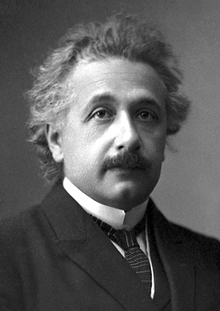Academic career
Academic career
In 1901, his paper "Folgerungen aus den Capillaritätserscheinungen" ("Conclusions from the Capillarity Phenomena") was published in the prestigious Annalen der Physik.[42][43] On 30 April 1905, Einstein completed his thesis, with Alfred Kleiner, Professor of Experimental Physics, serving as pro-forma advisor. Einstein was awarded a PhD by the University of Zürich. His dissertation was entitled "A New Determination of Molecular Dimensions."[44][45] This paper included Einstein's initial estimates of Avogadro constant as 2.2×1023 based on diffusion coefficients and viscosities of sugar solutions in water.[46] That same year, which has been called Einstein's annus mirabilis (miracle year), he published four groundbreaking papers, on the photoelectric effect, Brownian motion, special relativity, and the equivalence of mass and energy, which were to bring him to the notice of the academic world.
By 1908, he was recognized as a leading scientist, and he was appointed lecturer at the University of Bern. The following year, he quit the patent office and the lectureship to take the position of physics docent[47] at the University of Zürich. He became a full professor at Charles-Ferdinand University in Prague in 1911. Also in 1911, corrections of algebraic errors in his thesis brought Einstein's Avogadro constant estimate to 6.6×1023. In 1914, he returned to Germany after being appointed director of the Kaiser Wilhelm Institute for Physics (1914–1932)[48] and a professor at the Humboldt University of Berlin, with a special clause in his contract that freed him from most teaching obligations. He became a member of the Prussian Academy of Sciences. In 1916, Einstein was appointed president of the German Physical Society (1916–1918).[49][50]
During 1911, he had calculated that, based on his new theory of general relativity, light from another star would be bent by the Sun's gravity. That prediction was claimed confirmed by observations made by a British expedition led by Sir Arthur Eddington during the solar eclipse of 29 May 1919. International media reports of this made Einstein world famous. On 7 November 1919, the leading British newspaper The Times printed a banner headline that read: "Revolution in Science – New Theory of the Universe – Newtonian Ideas Overthrown".[51] Much later, questions were raised whether the measurements had been accurate enough to support Einstein's theory. In 1980 historians John Earman and Clark Glymour published an analysis suggesting that Eddington had suppressed unfavorable results.[52] The two reviewers found possible flaws in Eddington's selection of data, but their doubts, although widely quoted and, indeed, now with a "mythical" status almost equivalent to the status of the original observations, have not been confirmed.[53][54] Eddington's selection from the data seems valid and his team indeed made astronomical measurements verifying the theory.[55]
In 1921, Einstein was awarded the Nobel Prize in Physics for his explanation of the photoelectric effect, as relativity was considered still somewhat controversial. He also received the Copley Medal from the Royal Society in 1925.[2]

